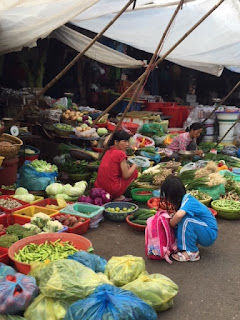Before we arrive at Hue, we drove by the Marble Mountain and stopped over at a shop where a lot of handmade marble products were displayed.
We made a stop over at a site that was covered with used motorbike tires. Obviously, their use is not beneficial to the water eco system, but ironically the scenery was tranquil and beautiful.
Hue used to be the imperial capital of the Nguyen Dynasty from 1802 - 1945. Hue was built after the Forbidden City of Beijing, but it is now a small town with a population of less than 400,000, but it still has Dai Noi Citadel that is surrounded by a moat and thick stone walls. It encompasses the Imperial City with palaces and shrines.
We passed through the main entrance of Ngo Mon Gate. We also passed through Thai Hoa Palace, the Halls of Mandarins, Nine Dynastic Urns and Forbidden Purple City ruins. Hue had a nick name of the Purple City because of the color purple was widely used.
In the evening, we joined the optional Trishaw (Cyclo) Ride to the dinner. It was a scary ride particularly at hte intersections where a lot of cars, motorcycles and cyclos are comingled to pass through without traffic signals. Moreover, fumes coming from all the cars and motorbikes were quite bad. We all wore masks, but they were surely not good enough.
The Cyclos went through a traditional market where we saw many merchants selling fruits and veggies.
The dinner was at a private house, probably former general or similar status with big house and many dining rooms. We were told that the foods we ate were the replicas of royal cuisine with a lot of decorations. I would say that the taste of the foods was not as good as the presentations. On the way back, we took a mini bus instead of the Cyclos. Whew...
The following day, we joined the optional tour of Perfume River Cruise. Along the river, there are many flowers which provided fragrance, hence the name. The excursion on a double dragon head boat included the exploration of the life along the banks of the ancient royal capital city. These types of dragon boats were used by the Royal Family on festive days. The gentle perfume river, supposedly blue in color but not really in reality, is dotted with a poetic landscape of boats, gardens, pagodas, towers and temples. Our excursion stopped over at Thien Mu Pagoda on the north bank of the river. It was built in 1601 and in seven consecutive tiers.
We stopped over at a place that makes incenses to be used at the temples. Also, we visited a tomb of a king called Teuk Leuk. This was one of seven such tombs in Hue.

















































No comments:
Post a Comment